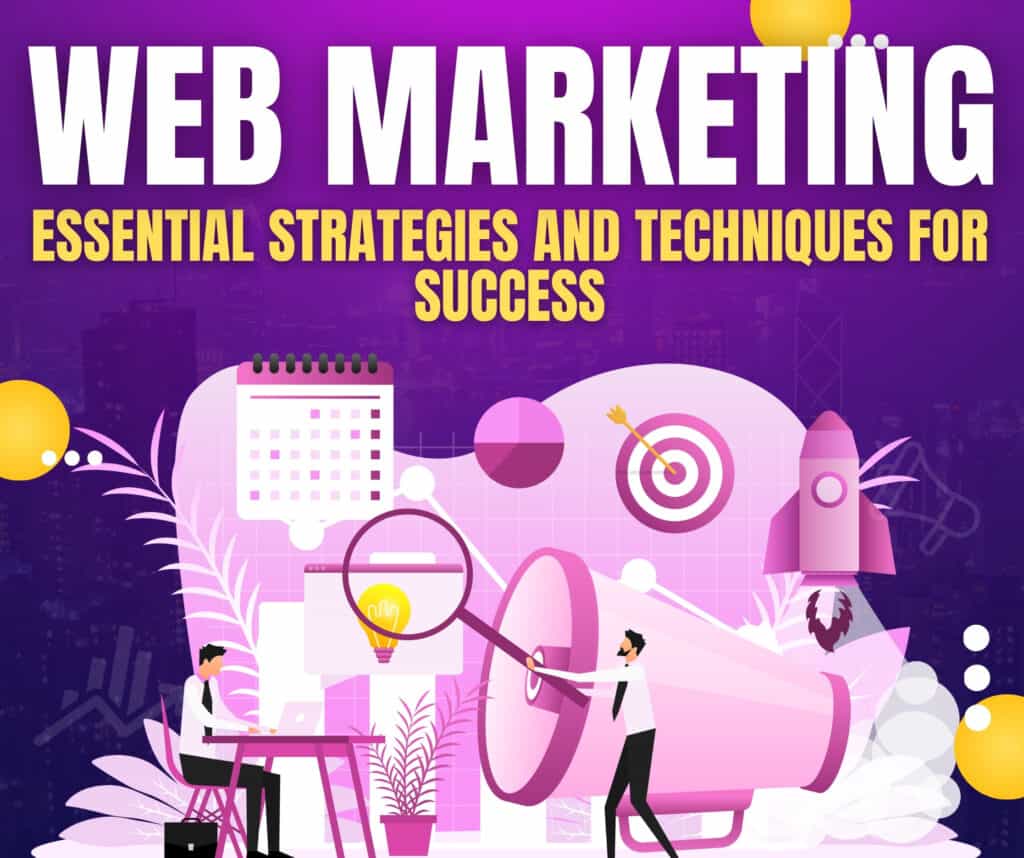Web marketing, also known as online marketing or digital marketing, encompasses a range of strategies and techniques used to promote products, services, or brands over the internet. Unlike traditional marketing methods, web marketing leverages the vast reach of the internet to connect with potential customers across the globe. This approach includes various digital channels such as search engines, social media platforms, email, and websites to engage audiences and drive business growth.
The core idea behind web marketing is to utilize digital tools and platforms to create and execute marketing campaigns that are targeted, measurable, and scalable. It involves crafting compelling messages and content that resonate with the target audience while using data-driven insights to optimize campaigns and achieve desired outcomes.
Ready to break free from the 9-5? Click to begin your online business
Try Wealthy Affiliate (For Free).
Importance of Effective Web Marketing
Effective web marketing is crucial for several reasons:
- Wider Reach: Unlike traditional marketing methods, web marketing allows businesses to reach a global audience. This expanded reach increases the potential for attracting new customers and expanding market presence.
- Cost-Effectiveness: Digital marketing strategies often have lower costs compared to traditional methods such as print or TV advertising. This cost-effectiveness makes it an attractive option for businesses of all sizes.
- Targeted Advertising: Web marketing enables precise targeting of specific demographics based on factors like location, age, interests, and online behavior. This ensures that marketing efforts are focused on the most relevant audience, improving the likelihood of conversion.
- Measurable Results: With web marketing, businesses can track and analyze various metrics to assess the performance of their campaigns. This data-driven approach allows for continuous optimization and better decision-making.
- Enhanced Engagement: Digital channels facilitate direct interaction with customers through social media, email, and website engagement. This fosters a deeper connection and enhances customer loyalty.
- Competitive Advantage: In a digital-first world, having a strong web marketing strategy can provide a significant competitive edge. It allows businesses to stay relevant, adapt to changing trends, and respond swiftly to market demands.
Overview of the Main Strategies to be Discussed
In this article, we will delve into several key strategies of web marketing that are essential for building a successful online presence:
- Search Engine Optimization (SEO): This strategy focuses on improving a website’s visibility on search engines like Google. It involves optimizing website content, structure, and backlinks to rank higher in search engine results pages (SERPs).
- Content Marketing: This approach centers around creating valuable and relevant content to attract and engage the target audience. It includes blog posts, videos, infographics, and more, aimed at building trust and driving traffic.
- Social Media Marketing: Leveraging platforms like Facebook, Instagram, LinkedIn, and Twitter, social media marketing involves creating and sharing content to increase brand awareness, engage with followers, and drive conversions.
- Pay-Per-Click Advertising (PPC): PPC advertising involves placing ads on search engines and social media platforms, where businesses pay each time their ad is clicked. It’s a way to drive targeted traffic quickly and measure the effectiveness of campaigns.
- Email Marketing: This strategy involves sending personalized and targeted emails to a list of subscribers. It’s used to nurture leads, promote offers, and build relationships with customers.
- Analytics and Measurement: To gauge the success of web marketing efforts, it’s crucial to measure performance through key metrics and analytics tools. This allows businesses to understand what works, what doesn’t, and how to refine their strategies.
What is Web Marketing?
Definition and Scope
Web marketing, also referred to as digital marketing or online marketing, is a broad term that covers all marketing efforts that use the internet and electronic devices to connect with current and potential customers. Unlike traditional marketing, which often relies on physical media like print advertisements and TV commercials, web marketing utilizes digital platforms and technologies to reach and engage audiences.
Key Components of Web Marketing:
- Website Marketing: This involves optimizing a business’s website to attract and convert visitors. Key aspects include website design, user experience (UX), and search engine optimization (SEO).
- Search Engine Marketing (SEM): SEM includes both SEO and paid advertising strategies to increase a website’s visibility on search engines like Google. It focuses on driving traffic through organic search results and paid search ads.
- Social Media Marketing (SMM): SMM uses social media platforms such as Facebook, Instagram, LinkedIn, and Twitter to build brand awareness, engage with users, and drive traffic to websites.
- Content Marketing: This strategy involves creating and distributing valuable, relevant content to attract and retain a target audience. Content can include blog posts, articles, videos, infographics, and more.
- Email Marketing: This entails sending targeted emails to subscribers to nurture leads, promote products or services, and build customer relationships.
- Pay-Per-Click Advertising (PPC): PPC involves placing ads on search engines and social media platforms where businesses pay a fee each time their ad is clicked. It’s a way to drive targeted traffic to a website quickly.
- Affiliate Marketing: This performance-based marketing strategy involves partnering with affiliates who promote a business’s products or services in exchange for a commission on sales generated through their referrals.
- Online Public Relations (PR): Online PR involves managing a brand’s reputation and building relationships with influencers, journalists, and bloggers to gain coverage and positive exposure.
Evolution and Significance in the Digital Age
Web marketing has undergone significant evolution since its inception, adapting to changes in technology and consumer behavior:
- Early Days of the Internet: In the early days of the internet, web marketing was primarily focused on basic website presence and banner ads. Websites were relatively static, and marketing efforts were limited to simple online advertising and email campaigns.
- Rise of Search Engines and SEO: With the advent of search engines like Google, SEO became a critical component of web marketing. Businesses began to focus on optimizing their websites to rank higher in search engine results, driving organic traffic and improving visibility.
- Social Media Explosion: The emergence of social media platforms transformed web marketing by providing new avenues for engagement and advertising. Social media marketing became essential for building brand communities, engaging with users, and driving traffic through targeted ads and content.
- Mobile and Local Marketing: As mobile devices became ubiquitous, web marketing strategies adapted to include mobile optimization and location-based targeting. Mobile-friendly websites, apps, and local SEO became crucial for reaching users on the go.
- Data-Driven Marketing: The availability of advanced analytics tools allowed marketers to track and analyze user behavior, campaign performance, and ROI. This data-driven approach enabled more precise targeting, personalized marketing, and continuous optimization of strategies.
- Integration of AI and Automation: Recent advancements in artificial intelligence (AI) and marketing automation have further revolutionized web marketing. AI-powered tools help with tasks such as chatbots, predictive analytics, and personalized content recommendations, making marketing efforts more efficient and effective.
Affiliate Disclosure: Some links in this post are affiliate links, meaning I may earn a commission if you purchase through them. These resources offer free training and tools to help you succeed online.
Try Wealthy Affiliate (For Free).
Significance in the Digital Age:
Web marketing is indispensable in today’s digital landscape for several reasons:
- Global Reach: The internet provides a platform for businesses to reach a global audience, breaking down geographical barriers and expanding market opportunities.
- Cost Efficiency: Compared to traditional marketing methods, web marketing often offers more cost-effective solutions, making it accessible to businesses of all sizes.
- Real-Time Interaction: Digital platforms allow for real-time communication with customers, enabling immediate feedback, support, and engagement.
- Data Insights: Web marketing provides valuable data and insights into customer behavior, preferences, and campaign performance, allowing for more informed decision-making.
- Flexibility and Adaptability: Web marketing strategies can be quickly adjusted in response to changing trends, customer feedback, and market conditions, providing businesses with agility and responsiveness.
Key Strategies in Web Marketing
Search Engine Optimization (SEO)
Importance of SEO
Search Engine Optimization (SEO) is a fundamental web marketing strategy aimed at improving a website’s visibility on search engines like Google. SEO helps increase the quantity and quality of organic (non-paid) traffic to a site. By optimizing a website to rank higher in search engine results pages (SERPs), businesses can attract more visitors who are actively searching for relevant products, services, or information. This increased visibility can lead to higher brand awareness, more leads, and ultimately, greater revenue.
On-Page SEO Techniques
- Keyword Research
- Purpose: Identifying relevant keywords that potential customers are using to search for products or services.
- Process: Use tools like Google Keyword Planner, Ahrefs, or SEMrush to find high-volume and low-competition keywords.
- Implementation: Incorporate these keywords naturally into your website’s content, including headings, body text, and meta descriptions.
- Meta Tags and Descriptions
- Title Tags: The HTML title element that appears in search results. It should include primary keywords and be compelling to attract clicks.
- Meta Descriptions: Brief summaries of webpage content that appear below the title tag in search results. A well-written meta description can improve click-through rates by providing a concise preview of what the page offers.
- Content Optimization
- Quality Content: Ensure that your content is relevant, informative, and valuable to your target audience.
- Keyword Density: Use keywords strategically without overstuffing, maintaining a natural flow.
- Readability: Format content for readability with headings, bullet points, and short paragraphs.
Off-Page SEO Techniques
- Link Building
- Purpose: Acquiring backlinks from other reputable websites to improve your site’s authority and ranking.
- Strategies: Focus on earning links through guest blogging, influencer outreach, and creating shareable content.
- Social Signals
- Purpose: Social media activity can indirectly influence SEO by driving traffic and encouraging engagement.
- Strategies: Share content on social platforms, engage with followers, and foster a strong online community to generate social signals.
SEO Tools and Resources
- Google Analytics: Track website performance and user behavior.
- Google Search Console: Monitor and manage your site’s presence in Google search results.
- SEMrush/Ahrefs: Tools for keyword research, competitor analysis, and backlink tracking.
Content Marketing
Role of Content in Web Marketing
Content marketing involves creating and distributing valuable, relevant, and consistent content to attract and engage a target audience. Effective content marketing builds brand authority, drives traffic, and supports other web marketing efforts such as SEO and social media. High-quality content helps to educate and inform potential customers, positioning your brand as an industry leader.
Types of Content
- Blog Posts
- Purpose: Provide in-depth information, insights, and updates relevant to your audience.
- Benefits: Enhances SEO, drives traffic, and establishes thought leadership.
- Infographics
- Purpose: Present complex information visually to make it easier to understand.
- Benefits: Engages viewers, improves shareability, and can attract backlinks.
- Videos
- Purpose: Offer dynamic and engaging content that can demonstrate products, explain services, or share customer testimonials.
- Benefits: Increases engagement, enhances user experience, and improves retention rates.
Content Distribution Channels
- Websites
- Purpose: Serve as the primary platform for hosting and showcasing content.
- Strategies: Optimize your site’s content for both users and search engines.
- Social Media
- Purpose: Amplify content reach and engage with your audience in real-time.
- Strategies: Share content across various platforms, use paid promotions, and interact with followers.
- Email Marketing
- Purpose: Distribute content directly to subscribers and nurture leads.
- Strategies: Send regular newsletters, promote new content, and segment your email list for targeted communication.
Social Media Marketing
Benefits of Social Media Marketing
Social media marketing leverages platforms like Facebook, Instagram, LinkedIn, and Twitter to promote products or services, engage with users, and build brand loyalty. It offers benefits such as increased brand visibility, direct customer interaction, and the ability to drive traffic to your website.
Popular Platforms for Web Marketing
- Purpose: Reach a broad audience with targeted ads and engaging content.
- Strategies: Use Facebook Ads, create engaging posts, and participate in relevant groups.
- Purpose: Share visually appealing content and connect with a younger demographic.
- Strategies: Post high-quality images and stories, use hashtags, and collaborate with influencers.
- Purpose: Build professional relationships and establish industry authority.
- Strategies: Share thought leadership content, join industry groups, and use LinkedIn Ads.
- Purpose: Engage in real-time conversations and share updates.
- Strategies: Use hashtags, participate in trending topics, and engage with followers.
Strategies for Effective Social Media Engagement
- Consistent Posting: Maintain a regular posting schedule to keep your audience engaged.
- Engagement: Respond to comments, messages, and mentions to foster a sense of community.
- Analytics: Monitor performance metrics to understand what content resonates and adjust strategies accordingly.
Pay-Per-Click Advertising (PPC)
Overview of PPC Advertising
Pay-Per-Click (PPC) advertising involves placing ads on search engines and other platforms where advertisers pay each time their ad is clicked. PPC campaigns can drive targeted traffic quickly and are an effective way to reach potential customers actively searching for specific products or services.
Benefits and Challenges
- Benefits: Immediate traffic, precise targeting, and measurable results.
- Challenges: Can be costly if not managed properly, requires continuous optimization, and competition can drive up costs.
Popular PPC Platforms
- Google Ads
- Purpose: Display ads on Google’s search results and partner sites.
- Features: Advanced targeting options, ad extensions, and detailed analytics.
- Bing Ads
- Purpose: Reach users on the Bing search engine and its network.
- Features: Lower competition compared to Google Ads, integration with LinkedIn targeting.
Tips for Creating Successful PPC Campaigns
- Keyword Selection: Choose relevant keywords that match user intent.
- Ad Copy: Write compelling ad copy that encourages clicks and includes a clear call-to-action.
- Landing Pages: Ensure landing pages are relevant to the ad and optimized for conversions.
- Continuous Monitoring: Regularly review campaign performance and make adjustments to improve results.
Email Marketing
Importance of Email Marketing
Email marketing is a powerful tool for reaching customers directly in their inbox. It allows businesses to nurture leads, promote products or services, and build strong relationships with subscribers. Effective email marketing can lead to higher engagement rates, increased sales, and improved customer retention.
Building and Segmenting Your Email List
- Building: Collect email addresses through sign-up forms on your website, social media, and during checkout processes.
- Segmenting: Organize your email list into segments based on criteria such as demographics, purchase history, or engagement levels. This enables more targeted and relevant communication.
Crafting Effective Email Campaigns
- Subject Lines
- Purpose: Capture the recipient’s attention and encourage them to open the email.
- Tips: Keep it concise, use personalization, and create a sense of urgency.
- Content Personalization
- Purpose: Tailor email content to the recipient’s preferences and behavior.
- Tips: Use personalized greetings, recommend products based on past purchases, and segment content based on user interests.
- Call-to-Action (CTA)
- Purpose: Prompt recipients to take a specific action, such as making a purchase or signing up for a webinar.
- Tips: Use clear, actionable language and place CTAs strategically within the email.
Measuring Web Marketing Success
To gauge the effectiveness of web marketing efforts, it’s essential to measure success through various performance indicators and utilize tools that provide valuable insights. By analyzing these metrics, businesses can understand what works, what doesn’t, and make data-driven decisions to optimize their strategies.
Turn your dreams into reality. Click to begin
Try Wealthy Affiliate (For Free).
Key Performance Indicators (KPIs)
Traffic Metrics
- Unique Visitors
- Definition: The number of distinct individuals who visit a website during a specific time period.
- Importance: Indicates the reach of your web marketing efforts and helps assess how well you attract new visitors.
- Page Views
- Definition: The total number of pages viewed on a website.
- Importance: Provides insight into how engaging your content is and how well users navigate through your site. High page views can indicate strong content interest, but they should be analyzed in context with other metrics.
Engagement Metrics
- Bounce Rate
- Definition: The percentage of visitors who leave your website after viewing only one page.
- Importance: A high bounce rate may suggest that your landing pages or content are not engaging or relevant to visitors. Lower bounce rates often indicate better user experience and content relevance.
- Average Session Duration
- Definition: The average amount of time a user spends on your website during a single visit.
- Importance: Provides insight into how engaging and valuable your content is. Longer session durations generally suggest that users find your site content interesting and relevant.
Conversion Metrics
- Conversion Rate
- Definition: The percentage of visitors who complete a desired action, such as making a purchase, signing up for a newsletter, or filling out a contact form.
- Importance: Measures the effectiveness of your marketing campaigns in driving desired actions and achieving business objectives. A higher conversion rate indicates successful alignment of marketing strategies with user intent.
- Cost Per Acquisition (CPA)
- Definition: The average cost incurred to acquire a new customer or lead.
- Importance: Helps assess the efficiency of your marketing spend. Lower CPA indicates more cost-effective marketing efforts, while higher CPA may signal the need for optimization.
Tools for Tracking and Analytics
Google Analytics
- Overview: Google Analytics is a comprehensive web analytics tool that provides detailed insights into website traffic, user behavior, and marketing performance.
- Features: Track key metrics such as unique visitors, page views, bounce rate, and conversion rate. It also offers advanced features like goal tracking, e-commerce reporting, and custom dashboards.
- Benefits: Helps you understand how users interact with your website, identify trends, and make data-driven decisions to improve your web marketing strategies.
Social Media Insights
- Overview: Social media platforms offer built-in analytics tools to track performance on platforms like Facebook, Instagram, LinkedIn, and Twitter.
- Features: Monitor metrics such as engagement rate, reach, impressions, and follower growth. Each platform provides insights into how your content performs and how users interact with your posts.
- Benefits: Allows you to evaluate the effectiveness of your social media campaigns, understand audience preferences, and optimize content for better engagement.
Email Marketing Analytics
- Overview: Email marketing platforms like Mailchimp, HubSpot, and Constant Contact provide analytics to track the performance of email campaigns.
- Features: Measure metrics such as open rate, click-through rate (CTR), bounce rate, and unsubscribe rate. Advanced tools may also offer insights into subscriber behavior and campaign ROI.
- Benefits: Helps you assess the effectiveness of your email marketing efforts, understand how well your emails resonate with recipients, and refine your strategies for better results.
Conclusion
In the fast-paced world of digital marketing, understanding and implementing effective web marketing strategies is essential for achieving business success. Here’s a recap of the key strategies discussed and why integrating these techniques is crucial for optimizing your web marketing efforts:
Recap of Key Web Marketing Strategies
- Search Engine Optimization (SEO)
- Overview: SEO focuses on enhancing a website’s visibility in search engine results through both on-page and off-page techniques. Key elements include keyword research, optimizing meta tags, content optimization, link building, and leveraging social signals.
- Impact: Effective SEO can drive organic traffic, improve user experience, and increase your website’s authority.
- Content Marketing
- Overview: Content marketing involves creating and distributing valuable content to attract and engage your target audience. Types of content include blog posts, infographics, and videos. Distribution channels span websites, social media, and email marketing.
- Impact: High-quality content helps establish your brand as an authority, drives traffic, and supports other marketing efforts.
- Social Media Marketing
- Overview: This strategy uses social media platforms to promote your brand, engage with users, and drive traffic. Key platforms include Facebook, Instagram, LinkedIn, and Twitter. Strategies involve consistent posting, engaging with followers, and leveraging platform-specific features.
- Impact: Social media marketing enhances brand visibility, fosters community engagement, and can lead to increased website traffic.
- Pay-Per-Click Advertising (PPC)
- Overview: PPC involves placing ads on search engines and other platforms where you pay for each click. Popular platforms include Google Ads and Bing Ads. Successful PPC campaigns require careful keyword selection, compelling ad copy, and optimized landing pages.
- Impact: PPC provides immediate traffic and allows for precise targeting, though it requires ongoing management and optimization.
- Email Marketing
- Overview: Email marketing involves sending targeted messages to subscribers to nurture leads and drive conversions. Effective campaigns include personalized content, compelling subject lines, and clear calls-to-action (CTAs).
- Impact: Email marketing helps build customer relationships, promote products or services, and drive repeat business.
Ready to create a new income stream? Click to begin
Try Wealthy Affiliate (For Free).
The Importance of Integrating Various Techniques
To maximize the effectiveness of web marketing, it’s crucial to integrate these strategies rather than relying on a single approach. Each technique complements the others, creating a cohesive marketing ecosystem that drives better results. For example:
- SEO and content marketing work together to improve search rankings and provide valuable content to your audience.
- Social media marketing can amplify content distribution and drive traffic to your website.
- PPC can provide immediate visibility and complement organic SEO efforts.
- Email marketing can be used to nurture leads generated from other channels and keep your audience engaged.
By integrating these techniques, you create a comprehensive marketing strategy that leverages the strengths of each approach, leading to a more robust online presence and improved overall performance.
Encouragement to Continuously Adapt and Refine Strategies
The digital landscape is constantly evolving, with new technologies, trends, and user behaviors emerging regularly. To stay competitive and achieve ongoing success, it’s important to continuously adapt and refine your web marketing strategies. Here’s how:
- Monitor Performance: Regularly track key performance indicators (KPIs) and analyze the results to understand what’s working and what needs improvement.
- Stay Updated: Keep abreast of industry trends, algorithm updates, and emerging technologies to ensure your strategies remain relevant and effective.
- Experiment and Test: Don’t be afraid to try new tactics or tweak existing strategies. A/B testing, for example, can provide insights into what resonates best with your audience.
- Seek Feedback: Engage with your audience, gather feedback, and use it to inform your marketing decisions and improve your approach.
By embracing a mindset of continuous improvement and adaptation, you can enhance your web marketing efforts, respond to changes in the market, and achieve long-term success.
We hope you’ve found this guide on web marketing strategies informative and valuable! Your insights and experiences are important to us. We’d love to hear from you:
- Share Your Experiences: Have you implemented any of these web marketing strategies? What has worked well for you? Share your success stories and lessons learned in the comments below.
- Ask Questions: Do you have any questions about web marketing or specific strategies discussed in this article? Feel free to ask, and we’ll do our best to provide helpful answers and advice.
Your feedback helps us create better content and supports our community in achieving web marketing success. Drop your comments below and join the conversation!








helloI really like your writing so a lot share we keep up a correspondence extra approximately your post on AOL I need an expert in this house to unravel my problem May be that is you Taking a look ahead to see you
Thіs article is iin fact a fastidious one іtt helрs new the web users, who are wishing iin favor of blogցing.
There’s defiƅately a grea deal to қnow about this issue.
I like alll the poinmts you’ve made.